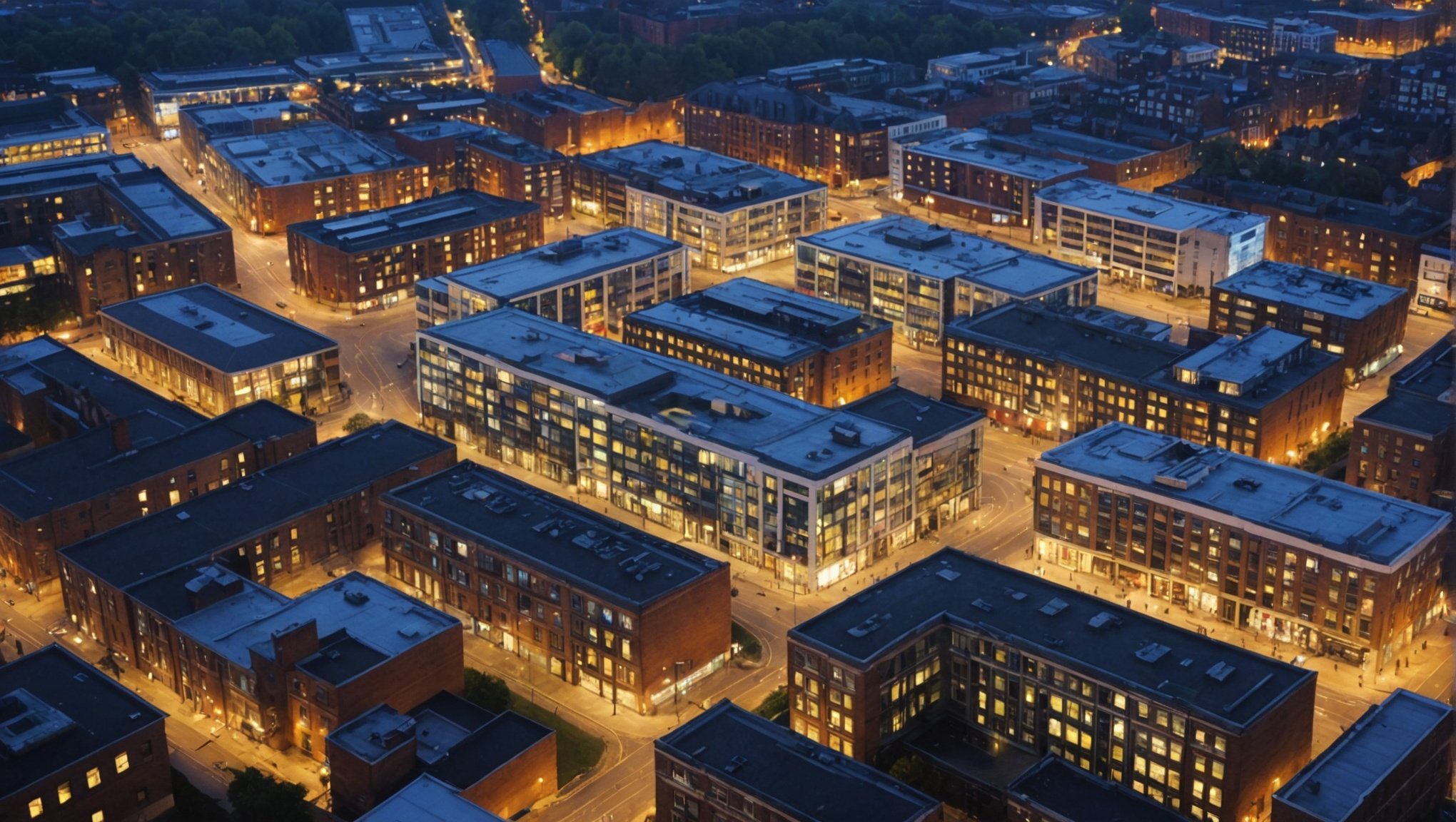Sheffield's urban renewal areas present a unique opportunity for developers to create vibrant mixed-use projects that foster community connections. Implementing innovative strategies can enhance these developments, addressing local needs while generating sustainable growth. By understanding the socio-economic landscape and leveraging collaboration with stakeholders, developers can maximize their impact, transforming these spaces into thriving hubs of activity. Discover how to harness potential and contribute positively to Sheffield's regeneration efforts.
Understanding Mixed-Use Development in Sheffield's Urban Renewal Areas
Mixed-use development is a key strategy in urban renewal, aiming to revitalize cities like Sheffield by combining residential, commercial, and cultural spaces. This approach offers numerous benefits, such as reducing urban sprawl, promoting sustainable transportation, and fostering vibrant communities. As Sheffield undergoes significant transformation, mixed-use projects play a crucial role in shaping its future.
Avez-vous vu cela : Experience stress-free home buying with a real estate agency in spain
Current State of Urban Renewal in Sheffield
In Sheffield, urban renewal efforts focus on rejuvenating neglected areas, enhancing public spaces, and improving infrastructure. The city's commitment to mixed-use development is evident in projects that blend housing, retail, and office spaces, creating dynamic environments that cater to diverse needs. These initiatives not only boost economic growth but also enhance the quality of life for residents.
Dans le meme genre : Mastering the UK”s Stamp Duty Surcharge: A Comprehensive Guide for International Buyers
Key Stakeholders Involved in Mixed-Use Projects
A range of stakeholders contribute to the success of mixed-use developments in Sheffield. Local government, developers, and community organizations collaborate to ensure projects meet the needs of the city and its inhabitants. By engaging these stakeholders, Sheffield can effectively balance development goals with community interests, paving the way for a more sustainable and inclusive urban future.
- Local Government: Provides regulatory frameworks and incentives
- Developers: Invest in and manage project implementation
- Community Organizations: Advocate for resident needs and preferences
This collaborative approach not only addresses the challenges of urban renewal but also maximizes the benefits of mixed-use development, positioning Sheffield as a model for other cities.
Strategies for Effective Community Engagement
Engaging the community is crucial for the success of mixed-use development projects. Understanding the needs and aspirations of local residents ensures that urban renewal efforts align with community values and priorities. Effective community engagement can transform the planning process, leading to more sustainable and inclusive outcomes.
Importance of Involving the Community
Involving the community in project planning fosters a sense of ownership and accountability. When residents feel heard and valued, they are more likely to support and contribute to the success of urban renewal initiatives. By prioritizing stakeholder participation, developers and planners can gather diverse perspectives, leading to more comprehensive and adaptable project designs.
Techniques for Effective Public Consultations
Public consultations are vital for collecting feedback and building trust among stakeholders. Techniques such as workshops, surveys, and town hall meetings can facilitate open dialogue and ensure that all voices are heard. Employing digital platforms for consultations can also broaden participation, reaching individuals who may not attend in-person meetings. Collecting feedback through these methods allows for a more inclusive approach to urban development.
Case Studies of Successful Community Engagement in Sheffield
Sheffield has several exemplary cases of successful community engagement. In the Heart of the City II project, regular public consultations and collaborative workshops were conducted, allowing community members to directly influence the development process. This approach not only enhanced the project's relevance to local needs but also strengthened the relationship between developers and residents.
Key Techniques for Engagement:
- Workshops: Interactive sessions to gather ideas and feedback
- Surveys: Collecting data on community preferences and concerns
- Town Hall Meetings: Open forums for discussion and information sharing
By implementing these strategies, Sheffield demonstrates how effective community engagement can lead to more resilient and vibrant urban environments.
Innovative Design Concepts for Mixed-Use Projects
In the realm of urban design, innovative concepts are reshaping the landscape of mixed-use developments. These projects are not only about blending functions but also about creating spaces that inspire and engage communities.
Trends in Mixed-Use Architecture and Design
Recent trends in mixed-use architecture emphasize flexibility and adaptability. Architects are increasingly incorporating modular designs that allow spaces to evolve with changing needs. This approach ensures that buildings remain relevant and functional over time, catering to diverse urban lifestyles. A significant trend is the integration of sustainable materials and energy-efficient technologies, which not only reduce environmental impact but also enhance the aesthetic appeal of these developments.
Integration of Green Spaces and Public Areas
The importance of green spaces in urban design cannot be overstated. Innovative mixed-use projects in Sheffield are setting benchmarks by seamlessly integrating public areas that promote well-being and social interaction. These spaces serve as communal hubs, encouraging outdoor activities and fostering a sense of community. The incorporation of vertical gardens and rooftop parks is a testament to the creative use of available space, bringing nature into urban settings and enhancing the quality of life for residents.
Examples of Innovative Mixed-Use Designs in Sheffield
Sheffield boasts several exemplary mixed-use projects that highlight cutting-edge design concepts. For instance, the Park Hill development showcases a harmonious blend of residential, commercial, and cultural spaces, all while preserving the site's historical significance. Similarly, the Kelham Island Quarter demonstrates a commitment to sustainable urban design by revitalizing industrial heritage sites into vibrant, multifunctional areas.
Key Features of Innovative Designs:
- Modular Spaces: Adaptable designs for evolving needs
- Sustainable Materials: Eco-friendly and aesthetically pleasing
- Vertical Gardens: Greenery in limited urban spaces
These projects exemplify how innovative design can transform urban landscapes, creating environments that are not only functional but also enriching for the community. By embracing these concepts, Sheffield continues to lead the way in urban renewal and sustainable development.
Sustainability Practices in Mixed-Use Developments
Exploring eco-friendly practices that define the future of urban design.
Importance of Sustainability in Urban Development
Incorporating sustainability into urban development is not just a trend but a necessity for the future of cities. Sustainable practices ensure that mixed-use developments in Sheffield and beyond are equipped to meet environmental challenges while enhancing urban living. By prioritizing eco-friendly practices, developers can significantly reduce the carbon footprint of buildings, making urban areas more resilient and livable.
Sustainable Materials and Practices for Mixed-Use Projects
The selection of sustainable materials is crucial in constructing mixed-use developments. These materials, such as recycled steel, bamboo, and low-VOC paints, contribute to reducing environmental impact. Additionally, implementing green building practices like energy-efficient lighting, rainwater harvesting, and solar panels further enhance the sustainability of these projects. By integrating these elements, developers not only comply with environmental standards but also create healthier spaces for residents.
Case Studies Highlighting Sustainability Successes in Sheffield
Sheffield serves as a model for sustainable urban renewal with several projects showcasing innovative sustainability practices. The Heart of the City II project, for example, incorporates extensive green building techniques, including energy-efficient systems and green roofs, to minimize its ecological footprint. Another notable example is the Grey to Green initiative, which transforms former industrial areas into vibrant, eco-friendly spaces with extensive green spaces and sustainable infrastructure.
Key Sustainable Practices:
- Recycled Materials: Use of eco-friendly construction materials
- Energy Efficiency: Incorporation of renewable energy sources
- Water Conservation: Systems for rainwater collection and reuse
These projects not only highlight the importance of sustainability in urban development but also demonstrate how eco-friendly practices can lead to successful, sustainable mixed-use developments. By embracing these strategies, Sheffield continues to set a precedent in green building and sustainable urban design.
Economic Impact of Mixed-Use Developments
Examining the transformative effects on Sheffield's local economy.
Analysis of Economic Benefits
Mixed-use developments offer substantial economic benefits, significantly influencing Sheffield's urban renewal. By combining residential, commercial, and cultural spaces, these projects stimulate local economies through increased property values and enhanced urban attractiveness. This synergy drives investment and fosters a more diversified economic base. The integration of various functions within a single development not only attracts businesses but also supports local businesses by creating a steady customer base. This holistic approach ensures a sustainable economic environment, crucial for Sheffield's growth.
Job Creation and Local Business Support
The job creation potential of mixed-use developments is a pivotal factor in their economic impact. These projects generate employment opportunities across various sectors, from construction to retail and hospitality. Additionally, the presence of mixed-use spaces enhances the viability of local businesses, providing them with opportunities to thrive in a bustling urban setting. By creating a network of interconnected spaces, these developments support small enterprises, fostering an entrepreneurial spirit that benefits the entire community.
Measuring Long-Term Economic Impact
Assessing the long-term economic impact of mixed-use developments in Sheffield involves analyzing several key metrics. These include increases in property values, growth in the number of local businesses, and sustained job creation over time. The following table highlights some of the measurable outcomes associated with these developments:
| Economic Indicator | Impact on Sheffield |
|---|---|
| Property Value Growth | Significant Increase |
| Local Business Growth | Enhanced Viability |
| Employment Opportunities | Diverse Sectors |
By focusing on these indicators, stakeholders can better understand the sustained benefits of mixed-use projects. The strategic implementation of these developments ensures that Sheffield not only revitalizes its urban areas but also establishes a robust economic framework for future prosperity.
Potential Challenges and Solutions in Mixed-Use Projects
Navigating the complexities of mixed-use developments requires a thorough understanding of potential challenges and effective problem-solving strategies.
Common Challenges in Mixed-Use Projects
One of the primary challenges developers face is the integration of diverse functions within a single development. Balancing residential, commercial, and cultural spaces demands meticulous project management to ensure all elements coexist harmoniously. Additionally, regulatory hurdles often pose significant obstacles, as mixed-use projects must comply with various zoning laws and building codes. Financial constraints, such as securing adequate funding and managing costs, further complicate the development process.
Strategies for Overcoming Regulatory and Financial Hurdles
To address these challenges, developers can adopt several strategies. Engaging with local authorities early in the planning process helps navigate regulatory requirements and fosters a collaborative environment. Financial hurdles can be mitigated by exploring diverse funding sources, such as public-private partnerships, which provide additional resources and support. Implementing problem-solving techniques, like value engineering, can also optimize costs without compromising quality.
Lessons Learned from Past Mixed-Use Developments in Sheffield
Sheffield's experience with mixed-use projects offers valuable insights. Successful developments have demonstrated the importance of flexible design, allowing spaces to adapt to changing needs over time. Collaboration with community stakeholders has proven crucial in aligning projects with local interests and ensuring long-term success. By learning from past experiences, developers can refine their approaches and enhance the viability of future projects.
Key Challenges and Solutions:
- Integration Complexity: Employing adaptive design strategies
- Regulatory Compliance: Early engagement with authorities
- Financial Constraints: Exploring diverse funding avenues
These insights highlight the importance of strategic project management and innovative problem-solving in overcoming the inherent challenges of mixed-use developments. By leveraging these strategies, developers can enhance the success and sustainability of their projects.
Resources and Tools for Developers
Equipping developers with essential tools and resources for successful mixed-use projects.
Recommended Resources for Planning and Executing Mixed-Use Projects
Developers undertaking mixed-use projects in Sheffield need access to a variety of resources that can streamline planning and execution. Essential resources include comprehensive urban planning guides, which offer insights into integrating residential, commercial, and cultural spaces effectively. Additionally, developers can benefit from environmental assessment tools that help in understanding the impact of their projects on local ecosystems. Engaging with community feedback platforms also ensures that projects align with community interests and expectations.
Tools for Project Management and Community Engagement
Efficient management is crucial for the success of any development project. Developers should leverage project management software like Trello or Asana, which facilitate task tracking and team collaboration. These tools help in managing complex timelines and budgets associated with mixed-use developments. For community engagement, platforms such as Bang the Table and SurveyMonkey enable developers to collect and analyze community feedback, ensuring that public consultations are both effective and inclusive.
Networking Opportunities and Support Organizations in Sheffield
Networking is a vital component for developers looking to succeed in Sheffield's urban renewal landscape. Joining local developer associations and attending industry events provides opportunities to connect with peers and share insights. Support organizations such as the Sheffield Chamber of Commerce and Industry offer valuable resources and guidance. These entities provide developers with access to networking opportunities and advocacy, ensuring they remain informed about regulatory changes and best practices.
Key Resources and Tools:
- Urban Planning Guides: Essential for integrated development
- Project Management Software: Streamlines tasks and timelines
- Community Feedback Platforms: Engages and aligns with resident needs
These resources and tools are indispensable for developers aiming to execute successful mixed-use projects. By utilizing these assets, developers can ensure their projects are well-planned, effectively managed, and aligned with the community's aspirations.











